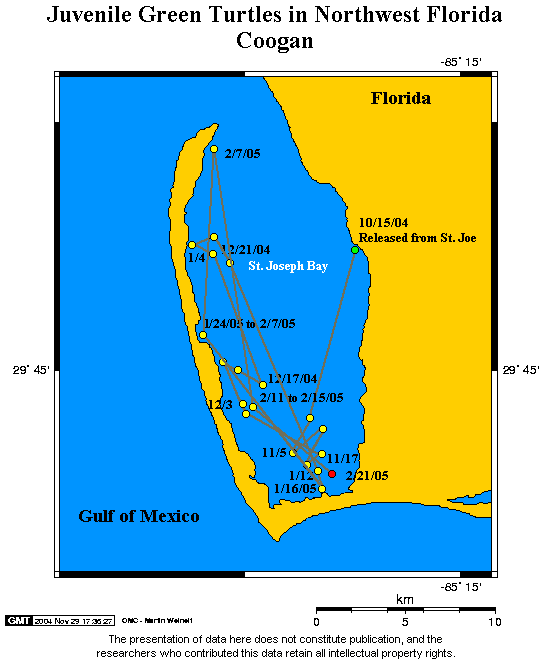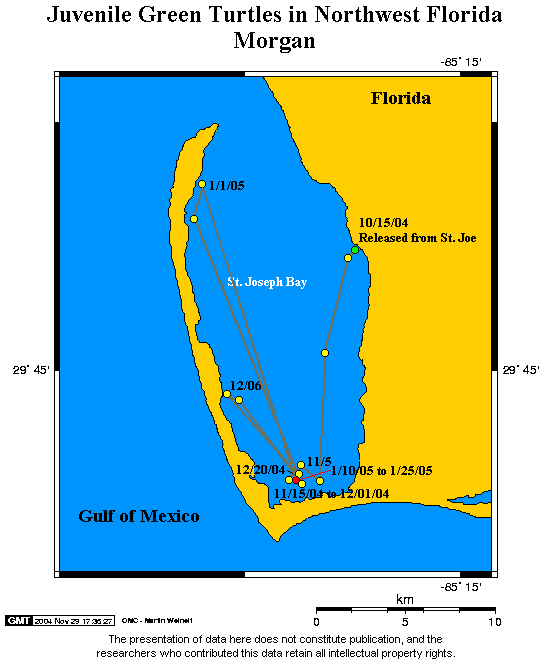In October of 2004, satellite transmitters were deployed on three juvenile green turtles from St. Joseph Bay, Florida by researchers with the Florida Cooperative Fish & Wildlife Research Unit at the University of Florida. These turtles ranged from 36 cm to 42 cm straight carapace length. This study is our second satellite tracking experiment with juvenile green turtles in St. Joseph Bay, Florida. We are continuing our research into understanding the overwintering strategies utilized by juvenile sea turtles in temperate developmental grounds. In the past, we have tracked cold-stunned juvenile greens which were unable to dive, and required rehabilitation prior to release. These turtles were released not in St. Joseph Bay, their area of stranding, but instead to the warmer waters of the Gulf of Mexico, south of St. Joseph Bay. This year, in 2004, we are tracking three juvenile green turtles that were captured in what appeared to be good health. These turtles were released on October 15th directly into St. Joseph Bay and it is our hope to document their movements and behavior as water temperatures drop during the winter months. It is believed that these turtles may either exit St. Joseph Bay and move to warmer waters, or instead overwinter in St. Joseph Bay and risk being cold stunned.
Assistance has been provided by the Florida Fish & Wildlife Research Institute, University of Central Florida Marine Turtle Research Group, as well as the Southwest Fisheries Science Center of the National Marine Fisheries Service.
Financial support has been provided by the Florida Sea Turtle License Plate Grants Program, Project AWARE Foundation, the Natural Resources Division of Eglin Air Force Base. Special thanks to BAE Personnel at Site D3 on Cape San Blas and the folks at St. Joseph Bay Buffer Preserve!
For more information on sea turtles, check out the Sea Turtles Information section of our website.
Click on the turtle’s name to see a map of its movements.
COOGAN – Coogan was captured in the southern end of St. Joseph Bay on one of those perfect netting days where turtle heads could be seen from miles away. Coogan was chosen to carry a transmitter because this turtle is approximately the same size as the average size of juvenile green turtles inhabiting St. Joseph Bay. Our hope is to document Coogan’s overwintering behavior and to determine if this turtle leaves St. Josepeh Bay in the fall and moves to warmer water, or instead overwinters in St. Joseph Bay, possibly risking being stranded due to cold stunning episodes that have occured during three out of the past four winters.

DEWAYNE – Dewayne was captured in the southern end of St. Joseph Bay on one of those netting days where the wind and the water dictate your every move, rain too. Dewayne was chosen to carry a transmitter because this turtle is approximately the same size as the average size of juvenile green turtles inhabiting St. Joseph Bay. Our hope is to document Dewayne’s overwintering behavior and to determine if this turtle leaves St. Josepeh Bay in the fall and moves to warmer water, or instead overwinters in St. Joseph Bay, possibly risking being stranded due to cold stunning episodes that have occurred during three out of the past four winters.
MORGAN – Morgan was captured in the southern end of St. Joseph Bay on one of those netting days where the wind and the water dictate your every move, rain too. Morgan was chosen to carry a transmitter because this turtle is approximately the same size as the average size of juvenile green turtles inhabiting St. Joseph Bay. Our hope is to document Morgan’s overwintering behavior and to determine if this turtle leaves St. Josepeh Bay in the fall and moves to warmer water, or instead overwinters in St. Joseph Bay, possibly risking being stranded due to cold stunning episodes that have occurred during three out of the past four winters.
